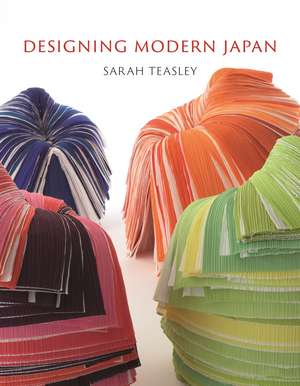Designing Modern Japan
Autor Sarah Teasleyen Limba Engleză Hardback – 22 apr 2022
From cars to cameras, design from Japan is ubiquitous. So are perceptions of Japanese design, from calming, carefully crafted minimalism to avant-garde catwalk fashion, or the cute, Kawaii aesthetic populating Tokyo streets. But these portrayals overlook the creativity, generosity, and sheer hard work that has gone into creating and maintaining design industries in Japan.
In Designing Modern Japan, Sarah Teasley deftly weaves together the personal stories of people who shaped and shape Japan’s design industries with social history, economic conditions, and geopolitics.. Key to her account is how design has been a strategy to help communities thrive during turbulent times, and for making life better along the way. Deeply researched and superbly illustrated, Designing Modern Japan appeals to a wide audience for Japanese design, history, and culture.
Preț: 236.90 lei
Preț vechi: 281.60 lei
-16% Nou
Puncte Express: 355
Preț estimativ în valută:
45.33€ • 47.45$ • 37.73£
45.33€ • 47.45$ • 37.73£
Carte disponibilă
Livrare economică 11-18 martie
Livrare express 22-28 februarie pentru 105.78 lei
Preluare comenzi: 021 569.72.76
Specificații
ISBN-13: 9781780232027
ISBN-10: 1780232020
Pagini: 424
Ilustrații: 75 color plates, 70 halftones
Dimensiuni: 171 x 222 x 33 mm
Greutate: 1.19 kg
Ediția:New.
Editura: REAKTION BOOKS
Colecția Reaktion Books
ISBN-10: 1780232020
Pagini: 424
Ilustrații: 75 color plates, 70 halftones
Dimensiuni: 171 x 222 x 33 mm
Greutate: 1.19 kg
Ediția:New.
Editura: REAKTION BOOKS
Colecția Reaktion Books
Notă biografică
Sarah Teasley is professor of design at RMIT University, Melbourne. She is coeditor of Global Design History.
Recenzii
"Teasley situates design movements within their political, economic, and social contexts to elucidate not just the how of design but the why. The detailed background of historical processes makes the book accessible to nonspecialists and those in corollary fields like marketing and economic history. The inclusive approach covers a variety of design outlets: graphic design like magazine covers, advertising, and packaging; craft production like lacquer and ceramics; consumer goods like fans and cars; and intangibles like fashion all receive their due."
“Teasley draws on a rich and varied collection of sources to weave history, sociology, design commentary, and fascinating anecdotes into her account of the evolution of Japanese design following the country's Meiji Restoration of 1868. . . . Designing Modern Japan has much to offer readers who are interested in the cultural and social history of modern Japan as well as the many transformations of design in Japan as it emerged from a feudal society into a global economy. The photographs and illustrations, accompanied by Teasley's informed commentary, provide a fascinating glimpse into the lives of Japanese people and their aspirations at a time of tumultuous change from the late nineteenth century onward. . . . Peppered with fascinating historical data. . . . The meticulous research could make this book read almost like an academic study, but Teasley's accessible style and expert commentary make it equally rewarding for the general reader.”
"In this excellent book tracing the development of modern Japanese design over a century and a half, Teasley encourages communication between historians and scholars of design by weaving usually separate strands of scholarship into a rich fabric that is accessible and useful to students and scholars in both fields."
"A major contribution to the emergent and growing field of Japanese design history. . . . Needless to say, design history is intrinsically interdisciplinary, and Teasley's book, with its focus on lived experience, political economy, and Japan-centered analysis will prove revelatory and productive for scholars working in numerous disciplines. It is a major, field-building book that will be required reading for years to come."
“Teasley’s meticulously detailed account of Japanese design history gives a satisfyingly complete picture of design as a practice that people have—and continue—to use for their own end.”
“A vibrant and powerful decoding of the modern history of Japan through design. A new and incomparable classic.”
"This shrewd and elegantly illustrated book shows how Japanese designers and manufacturers have used design 'to weather change and sometimes as a lever to accelerate change.' Focusing on their institution-building and meaning-making activities, Teasley traces how a variety of carefully-designed objects and images circulated around Japan, through the empire, and across the globe. The result, like the objects under study, is the narrative they created of Japan itself as transnational, modernist, and enduring."







